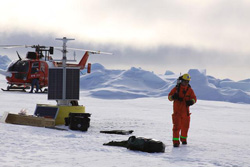Steve Lambert, WHOIAugust 26, 2012After steaming north all night we are now about 600 miles from the North Pole. The science team has been anticipating getting out on the ice to take samples, conduct surveys, and deploy at least a half dozen instruments but as we were steaming north the ice didn't look very encouraging. Our plan was to conduct reconnaissance flights to look for a floe, and then land on one that looked promising and drill test holes for thickness. While in transit, however, we happened on a nice floe just next to the ship and late morning the work began. Since most of the equipment was stored in the helicopter hangar and it needs to stay secured to prevent damage to the aircraft, most of the prep work was delayed until the last minute when the helo was wheeled out onto the flight deck and then the hangar was up for grabs. Suddenly twenty scientists converged in the hangar and started opening boxes and prepping equipment and sample containers. It was a real zoo! Then all of this had to be organized into helicopter loads and a flight plan devised. Since it was a large floe and the work was spread out and also since the helo has a pretty limited carrying capacity, the loads had to be well organized. The first couple of flights were personnel and small items that would fit in the trunk, then several sling loads were carried by the lifting strap attached to the bottom of the fuselage. The pilot made short work of several tons of equipment and the ice quickly became a very busy work station. As big as this ship is I was happy to get off for a while and (one of my favorite parts of the trip) flying in the helicopter! That is always a lot of fun. By the time I got out there most of the work stations had been planned by the survey team: locations for buoys, sampling stations and transect survey lines were in place. My job was to work with three of the instrument set-ups. The first, an Ice Mass Balance Buoy, went pretty quickly once I got the pieces out of this insane crate. The next were the Ice-Tethered profiler and Ice-Tethered MicroCAT. This ITP was rather unique in that it contained a large host of sampling equipment. I, along with Kris Newhall, Mike DeGrandpre, Gary Morgan, Rick Krishfield, Jim Dunn, Hugh Maclean, and Ed Bridgeman successfully deployed ITP 65 at about 80 degrees North on Sunday afternoon. This unit had undergone quite a lot of development and testing so this deployment was a big moment for the program. After all the hardware was installed I connected my laptop to the surface unit for final interrogation. After receiving confirmation that everything - including the SAMI - worked, my friend and colleague Mike DeGrandpre replied with, "REALLY??" Yes, Mike, it worked! Last updated: October 7, 2019 | |||||||||||||||||
Copyright ©2007 Woods Hole Oceanographic Institution, All Rights Reserved, Privacy Policy. | |||||||||||||||||



